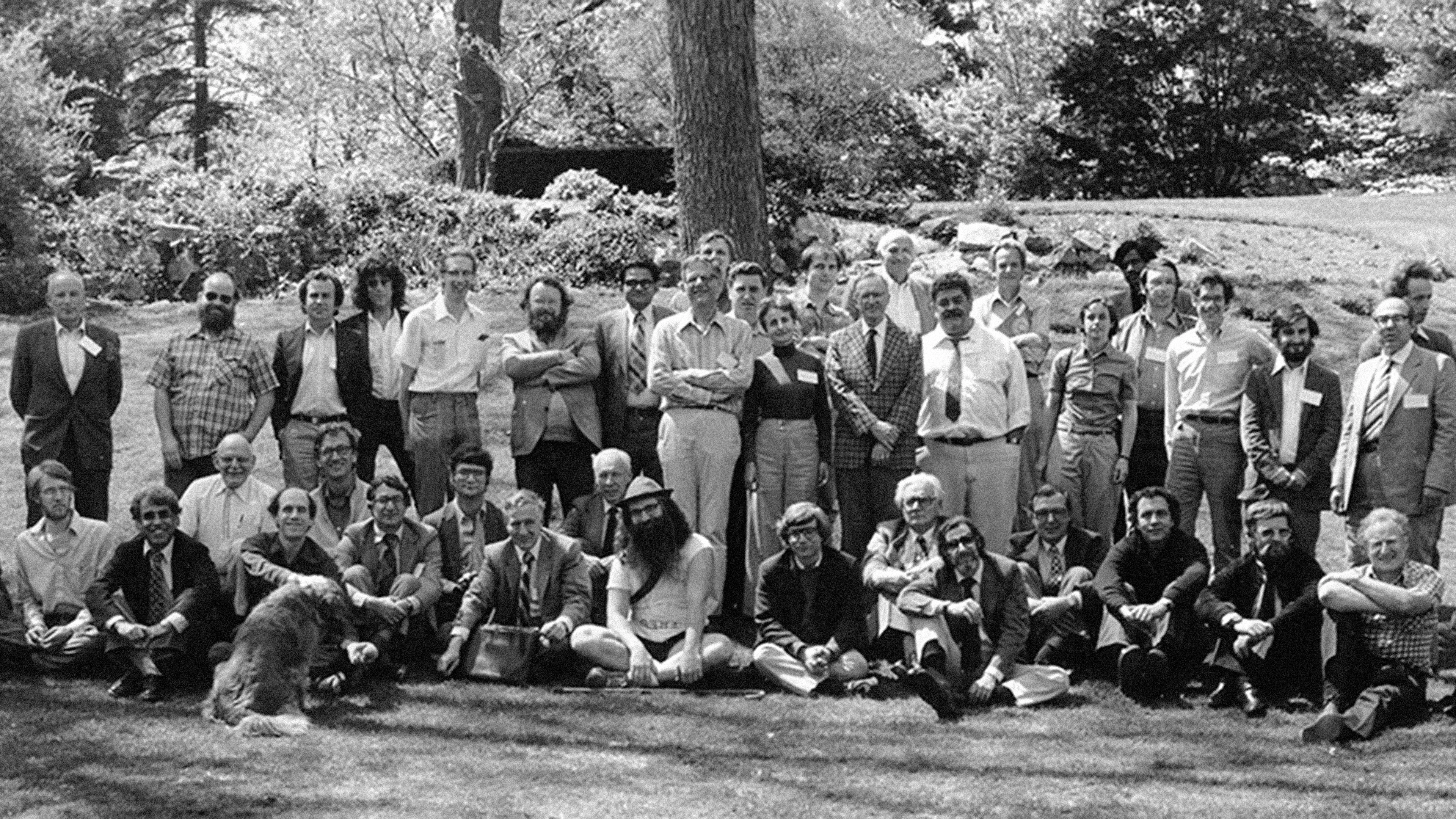Celebrating the 40-year anniversary of the Physics of Computation Conference
The QC40: Physics of Computation Conference will look back at the past 40 years of quantum computing progress, the state of the field today, and its future.
Forty years ago, a ragtag group of 50 thinkers arranged themselves for a photo on the lawn of MIT’s Endicott House. Few at the Physics of Computation Conference, jointly organized by MIT and IBM, thought they were making history in 1981. None had the conference’s subject as their day job. At the time the physics and computing were viewed as largely separate, and their overlap was mainly the subject of speculation.
Today, that conference holds more weight than any of us could have imagined. Perhaps due to the gravitas of its sponsoring institutions, and the fame of some of the attendees, it was arguably the birthplace of physics of computing, and especially the now-burgeoning field of quantum computing, as a serious subject worthy of a textbook or university course.
Some of the attendees had long been interested in physical limits of computing, including MIT’s Ed Fredkin and Tom Toffoli, and IBM’s Rolf Landauer, John Cocke, Gregory Chaitin, and me, Charlie Bennett (not in the conference photo because I took it) who had studied topics like the evolution of cellular automata, the energy cost of information processing, and whether the universe itself could be explained with the principles of computing. These conversations attracted some of the world’s most renowned thinkers, like Freeman Dyson, John Wheeler, and Richard Feynman to the conference at the stately Endicott House mansion, where we were as excited about the content as we were worried that one of us may accidentally knock an oil painting off of a wall during our talks.
At the time, quantum mechanics, though essential to the design of hardware devices such as transistors, was not viewed as having any fundamental relation to computation itself. Instead, it was seen as a nuisance, a source of noise, causing tiny devices to behave less reliably than their larger cousins. However, some physicists, like Stephen Wiesner and Alexander Holevo, had already began to think about positive uses of quantum effects in cryptography and what it might mean to replace classical information with quantum information in a communication channel. These ideas took hold slowly as more physicists began thinking about them; David Deutsch, for example, theorized that the quantum computer could be a useful model of physics overall, while Feynman realized that it would take exponential classical resources to simulate the quantum mathematics underlying our universe’s behavior.
The Physics of Computation Conference was a foundational forum where scientists were discussing these threads, and some of its attendees didn’t take it as seriously as you may think, at the time. But looking back on it, this conference now serves as an anchor point for scientists and institutions looking for a history and legitimacy to this field. It was a dedicated time and place to discuss the intersection of physics and computing, helping to braid these threads together. And it was at this conference where Feynman uttered his now-famous quote: “Nature isn’t classical, dammit, and if you want to make a simulation of nature, you’d better make it quantum mechanical, and by golly it’s a wonderful problem, because it doesn’t look so easy.”
Forty years later
These conversations slowly matured — and were perhaps still in the realm of shower musings — until 1994, when Peter Shor debuted his namesake algorithm, which demonstrated that not only could quantum computers be useful in simulating physics, but they could solve certain hard problems exponentially faster than classical computers could. The field has since exploded.
Today, research institutions, universities, and companies around the world have devoted resources to building quantum hardware and researching new algorithms. We may soon see quantum devices with advantages over classical computers when tackling the same problem. Federal governments have long since taken notice, devoting money and writing roadmaps to ensure that their countries have developed quantum expertise of their own.
Now that the groundwork has been laid, we’re in the position that we can think about quantum computers as technology, not just a science fiction experiment. Researchers are presenting results pushing the limits of these devices and finding new ways that they might be used to solve problems that are not only mathematically interesting but useful, providing benefits to humanity.
However, this field faces a dearth of traditionally underrepresented groups today, such as women, Black people, and LGBTQ+ people. If we’d like to see this technology deliver the most benefits and cause the least harm, we must include the most diverse set of voices as we build up the quantum community. We’re optimistic about the efforts to democratize access to these devices, like the global communities that have developed around programming quantum computers, and educational initiatives that prioritize bringing quantum education to the widest possible audiences. Looking into the future, we hope that a photo of the quantum computing community will include a lot more people — and a lot more diversity — than the 1981 photo.
We’re excited to once again host the QC40: Physics of Computation Conference in order to take a look back at the past 40 years of progress, review the state of the field today, and even look into the future to imagine where we’d like this field to go. We invite you to submit talks, watch panels, and engage with experts of quantum computing from then and now. We hope that, together, we can begin writing the next chapter of the history of quantum computing.
Related posts
- NewsMike Murphy
What’s next in computing is generative and quantum
NewsPeter HessTransitioning to quantum-safe communication: Adding Q-safe preference to OpenSSL TLSv1.3
Technical noteMartin Schmatz and David KelseyAI and quantum computing: How IBM showed up at SXSW 2025
NewsMike Murphy
